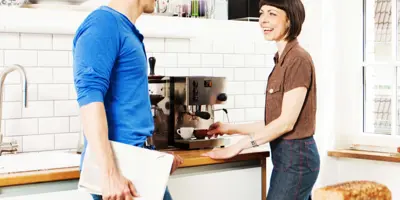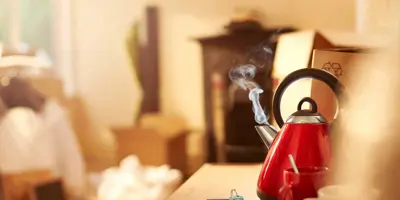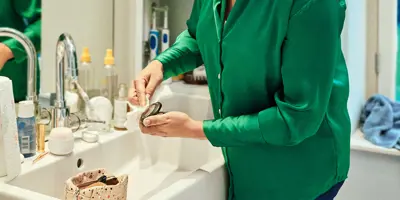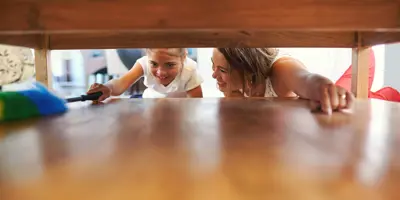2 people found this helpful

The wide, flat surface of a griddle is perfect for making delicious meals: yummy fry-ups with sizzling sausages, or maybe toasted sandwiches with cheese dripping down the sides. Even better when your partner decides to treat you to breakfast in bed with a huge stack of messy, sticky, oozing bacon pancakes.
The issue comes when you find the burnt remains of those pancakes still stuck to the griddle three weeks later. Suddenly, that labour-free breakfast doesn’t feel like such a luxury, after all. But trying to figure out how to remove the remains of an old blueberry without scratching your brand-new pan need not be a chore. With the right method, keeping your griddle clean is surprisingly easy, so you can enjoy your bacon pancakes in bed every week – if you’re lucky!
Here are two methods for cleaning your griddle: one for a relatively clean griddle that’s just been used, and one for a super dirty, back of the cupboard, might-be-a-bit-hairy type of griddle.
Let’s get started!
The secret to griddle cleaning straight after use
By the way, if you have a bit more to clean than just a griddle, you can use this process to clean coated pans or to keep a cast iron pan clean.
After you’ve just enjoyed the perfect sandwich, you might not be in the mood to clean a griddle, but it is best to give it a once-over after every use. This will help prevent any grease or food from building up on its surface. Just follow these simple steps:
- Let the griddle cool down to a warm temperature that’s safe to touch.
- Use a spatula to scrape off any residual food and grease that was left behind after cooking. You can use a metal scraper for some metal griddles but for cast iron pans and non-stick surfaces it’s safer to use plastic – in future you will be grateful you kept it scratch-free.
- Use a Plenty paper towel to wipe off the grease that you couldn’t get with the spatula.
- For the next stage of cleaning, pour a little water onto the griddle and let the warm metal heat it.
- Then use a scouring pad (nylon, not metal) to loosen up any surviving grease.
- Dry the griddle with a clean Plenty paper towel.
Once you have a clean pan or griddle, it’s time to rub the surface down with vegetable oil. We know you just spent all that time trying to remove the grease, but adding some oil (that isn’t mixed with the last thing you cooked) helps to preserve the non-stick properties of the griddle. You only need to use a teaspoon or two (depending on the surface area), and then remove the excess with an absorbent Plenty paper towel.
This step is also important when you clean coated pans or cast-iron pans.
Tip
Plenty household towels are extra absorbent, which means they do a great job both at soaking up grease and grime and at evenly distributing a thin coating of vegetable oil when polishing.
How to clean pans and griddles when they're really dirty
If you have found a griddle and realised that you can still see the last three meals you cooked ingrained into its surface, don’t despair! With the right method, it will soon be returned to its former glory – and then you can make a delicious treat to celebrate.
To get an encrusted griddle or cast pan clean, soaking is the best method. Griddles are very sensitive (aren’t we all), so you are better off staying away from harsh cleaning equipment or metal scouring pads.
- Start by soaking the surface of the pan or griddle in hot water, mixed with a little washing liquid.
- Then, being as gentle as possible, use a scouring sponge to loosen the softened layers of grease and burnt-on food.
- Hopefully, that will remove the worst of it, but you can always repeat these steps as many times as necessary to get your griddle and cast-iron pan clean.
- Once you’re happy with the results, dry your clean pan or griddle carefully with a sheet of Plenty kitchen towel. Celebrate your victory!
- As before, apply a little vegetable oil all over the surface with a Plenty kitchen towel and wipe off the excess.
And there you have it, a clean griddle (hopefully with the all-important non-stick still intact)! Now it’s time to get on with the difficult part: deciding what to cook next…
Related articles
How to clean a washing machine (the easy way)
Discover how and what to clean a washing machine with in 5 easy steps. Find out some of the best ways to clean washing machine interiors, exteriors and parts.

How to descale and deep clean your trusty coffee machine
Read on for a quick and simple way of descaling the coffee machine with vinegar, as well as instructions on how to clean a coffee maker without vinegar.

How to clean a deep fat fryer: 10 easy tips
Learn how to clean a deep fat fryer swiftly and safely! These 10 tips show you the best way to clean deep fat fryer interiors and exteriors.

Descale your kettle with vinegar and our spotless kettle cleaning hacks
Got a limescale kettle problem? In this article we show you exactly how to sort it. Read our guide to getting a clean kettle with vinegar or lemons.

How to remove limescale around the house — gently
Want to know how to get rid of limescale gently? Discover two brilliant yet natural ways to remove limescale from taps, toilets and sinks here.

How to spring clean your home when it’s in desperate need
What should be on your spring-cleaning checklist? Read this guide for your comprehensive on how to spring clean.



